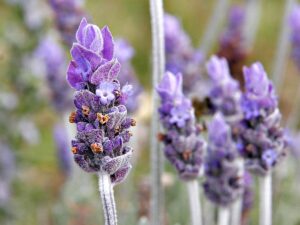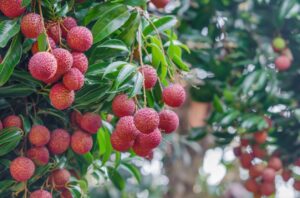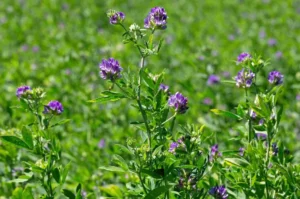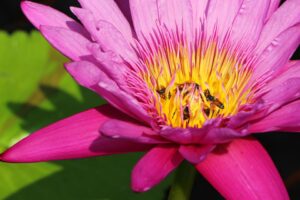Nettle
Leaf

Nettle Leaf is a versatile herb known for its numerous health benefits and uses in traditional medicine. It is often used for its nutritional content and its ability to support various aspects of health and well-being. Nettle Leaf is a herbaceous perennial plant with stinging hairs on its leaves and stems. Despite its sting, it has been used for centuries for its medicinal properties. Nettle is valued for its high nutrient content and is commonly used in teas, tinctures, and culinary dishes.
1. Size:
- Nettle Leaf typically grows between 2 to 4 feet (60 to 120 cm) tall. The plant can spread outwards to about 2 feet (60 cm) wide, forming a dense cluster.
2. Color:
- The leaves are dark green and have a somewhat serrated edge. Nettle plants produce small, greenish flowers that are not particularly showy.
3. Texture:
- The leaves have a coarse texture with tiny, stinging hairs that can irritate the skin upon contact. The stems are sturdy and also covered in stinging hairs.
4. Fragrance:
- Nettle Leaf has a mild, herbaceous aroma with a hint of earthiness. The smell is not strong but is noticeable when the leaves are crushed or brewed.
5. Uses:
- Nettle Leaf is known for its anti-inflammatory, antioxidant, and diuretic properties. It is often used to support joint health, reduce allergy symptoms, and improve urinary function.
- The leaves can be used in soups, teas, and salads after being cooked or steamed to neutralize their stinging effect.
- Nettle is used in topical treatments to soothe and treat skin conditions such as eczema and acne.
6. Habitat:
- Nettle Leaf thrives in a variety of environments, including moist, nutrient-rich soils in shaded or partially shaded areas. It is commonly found in woodlands, meadows, and along riverbanks.
- Nettle is native to Europe, Asia, and North America, and can be grown in many temperate regions.
7. Cultural Significance:
- Nettle Leaf has a long history in traditional medicine, particularly in European and Native American practices. It has been used for its purported ability to alleviate symptoms of arthritis, allergies, and other ailments.
- In folklore, nettle has been associated with protection and healing, often used in rituals and remedies for its purifying qualities.
Spiritual Properties
- Purification and Protection: Nettle Leaf is believed to have protective and purifying properties. It is used in spiritual practices to cleanse spaces and protect against negative energies.
- Strength and Resilience: The plant’s ability to thrive in various conditions symbolizes strength and resilience, often used in rituals to enhance personal fortitude and mental clarity.
Medicinal Properties
- Anti-inflammatory: Nettle Leaf has anti-inflammatory properties that can help reduce pain and swelling, particularly in conditions like arthritis.
- Antioxidant: The herb contains antioxidants that help protect cells from oxidative damage.
- Diuretic: Nettle Leaf acts as a natural diuretic, promoting healthy urinary function and reducing fluid retention.
- Nutritional: It is rich in vitamins and minerals, including vitamin C, iron, and calcium, which support overall health.
Adverse Actions & Side Effects
- Skin Irritation: Direct contact with fresh nettle leaves can cause skin irritation or a stinging sensation.
- Interactions with Medications: Nettle may interact with certain medications, such as blood thinners or diuretics, potentially affecting their efficacy.
Side Effects:
- Digestive Upset: Ingesting large amounts of nettle or its supplements can cause digestive issues such as nausea or upset stomach.
- Allergic Reactions: Some individuals may experience allergic reactions, including rash or itching.
- Blood Pressure Changes: Nettle may affect blood pressure, so individuals with hypertension should consult a healthcare provider before use.

Xylopia
Xylopia Xylopia, also known as Xylopia aethiopica, is a spice derived from the dried fruits of a tree native to West Africa. The tree produces

Lavender Flowers
Lavender Flowers Lavender flowers (Lavandula angustifolia) are cherished for their beauty, fragrance, and therapeutic properties. These small, purple blossoms grow in clusters on slender stems

Lychee Berries
Lychee Berries Lychee Berries are tropical fruits known for their sweet flavor and distinctive appearance. They are highly valued in culinary applications and traditional medicine

Alfalfa Leaves
Alfalfa Leaves Alfalfa is a perennial flowering plant from the legume family, known for its high nutrient content. It is widely cultivated as a forage

Jericho
Jericho Jericho, also known as Rose of Jericho or Anastatica hierochuntica, is a fascinating plant known for its remarkable resurrection abilities and distinctive appearance. This

Lotus Stamens
Lotus Stamens Lotus Stamens are the reproductive parts of the lotus flower, known for their delicate structure and unique properties. The lotus is a symbol